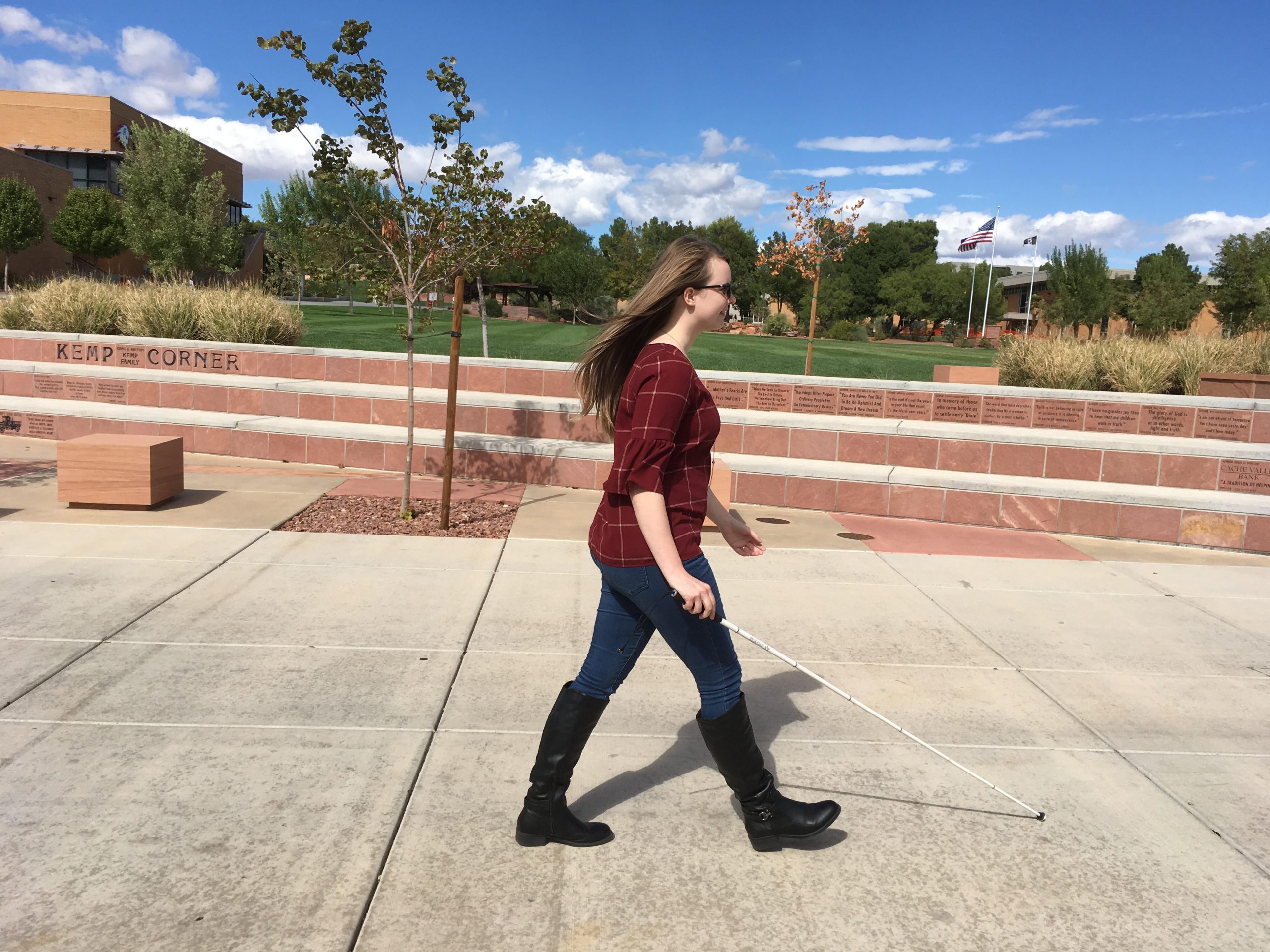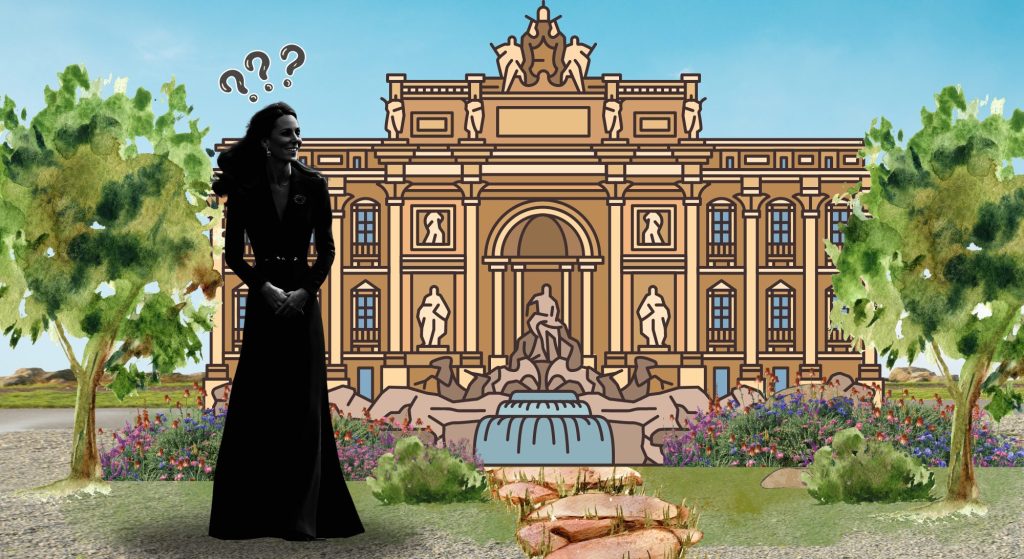By Brooke Garceau
I gather my backpack and jacket as the bus driver’s voice sounds over the intercom: “Dixie State University. Transit Center. This bus will continue as Route Three.”
The bus turns the corner and slows as the driver guides it into line behind the Route One and Two buses. I pull my glasses case out of my bag and quickly switch my regular glasses for prescription sunglasses before I have to face the painfully bright sun outside. I wonder if people are giving me strange looks because they assume anyone who uses a white cane is profoundly blind and shouldn’t need glasses of any kind.
What I tell everyone who asks is that I am legally blind, and when that elicits an awkward pause or fingers five inches from my face for me to count, I say, “I’m half blind,’ or, “Everything just looks really blurry to me,” or, “I can’t read that sign, but I can tell it’s there, and I think it resembles a sign.” Those kinds of explanations seem to satisfy people and allow them to put me in a sort of in-between category; somewhere between what they think of as able and disabled.
The bus doors whoosh open, and — sunglasses in place — I extend my cane in to feel my way toward the exit.
“Thank you,” I tell the bus driver over my shoulder at the same time that my cane moves from the edge of the bus step to the pavement below. I follow my cane’s instructions, step down from the bus, and head to my first class.
Profesora Fuentes displays a picture on the board. I know it’s a picture because she has just instructed the class to use “la foto” to play a speaking game. Because of my eye condition, the picture resembles a blurry collage of rainbow blobs and swirling lines, but I’m pretty sure she hasn’t used a Picasso painting for our food-description activity today.
I turn to my teammates and explain in Spanish that I can’t see the picture and ask if they will describe it to me before we begin playing the game. One of them begins to describe a plate of vibrant vegetables, rice and a juicy steak. Another reminds him not to forget the fork on the side. My professor notices that we have adapted the activity and says, “¡Qué buena solución!” (What a great solution!) And it was. I frequently have the opportunity to advocate for myself in this language course, a skill I use daily.
On my way to my magazine-writing class, I wait to cross the street. “Please wait… Please wait…” the crosswalk says every few moments. Then I hear the traffic slowing and stopping and the crosswalk saying, “Walk sign is on.” I tap my cane in front of me and continue toward my class. Sandwich boards dot the sidewalk. I hope I won’t accidentally knock any of them down and wonder what they say. They’re probably announcing an upcoming student event. I’ll have to check on the student government’s social media accounts later for details. But let’s be real here — I probably won’t.
A fellow English major passes out her next article to the class to peer-review during our next class session. We’re reviewing one of my pieces in just a few minutes. This piece is about White Cane Awareness Day, a national day of observance to celebrate the independence that using white canes gives to blind people. I pull out my handheld video magnifier so I can read and make notes on the paper in front of me. My magnifier is a little bigger than a phone and shows an enlarged image of my pen as I write “Title suggestions?” at the top of the page in preparation for our workshop time.
At the end of class, I stand up, unfold my white cane, which we’ve been talking about for the past 50 minutes, and head out the door. I leave the Jeffrey R. Holland Centennial Commons building, where I spend most of my time on campus as an English major, and immediately hear one of my favorite songs playing over speakers near the Kenneth S. Gardner Student Center. With every step I take toward the apparent gathering, a surging river of sounds grows louder and louder and drowns me in information.
Student government representatives stop students walking by. “Do you want a free t-shirt?” “Come to bingo tonight in the Gardner Center ballroom!” A girl’s nasally laugh calls my attention in one direction while the roar of a lawn mower pulls it in the opposite direction. Did someone just say my name? I say, “Hi!” Just in case in the general direction where I thought I heard a familiar voice. I feel a little guilty for not recognizing the person’s voice and wish whoever it was had identified themself.
Snippets of five different conversations surround me: “She said she’d meet us here. Where—”; “How’d you do on that last test?”; “—shoved the whole taco in his mouth and—”; “—so racist! Can you—”; “—started new meds, so hopefully—.”
A phone rings, playing “Bohemian Rhapsody.” The lawn mower has moved closer to me, overpowering many of the other sounds around me. All the while, music blares from the speakers I’ve just passed.
While all of this sounds fun — or at least interesting — it also sounds like a whole lot of noise. I can no longer hear the sounds of people’s voices or my tapping cane bouncing off of the buildings, trees, and signs around me. Instead of creating a mental picture for me of the surrounding landscape and obstacles, the music and voices around me paint a jumble of student life. I slow my pace just a bit and pay extra attention to what I’m feeling with my cane. I listen a little more for auditory cues so I won’t run into anyone or anything as I wade through the crowd.
At the Disabilities Resource Center tucked away in a far north corner of campus, Hillary says, “Hello, Brooke! How is your day going?”
Dr. Wells has sent over my literature test. Hillary takes me into the room with the CCTV, a tabletop video magnifier so that I can start the exam. I unload the three books marked by too many sticky notes that I’ll need to write the analysis sections of this exam and set them on the table. Next I set up my iPad, put my earbuds in, turn on VoiceOver (a software that reads the screen and anything I input out loud), and wait for the email from the DRC’s secretary containing my exam.
After two and a half hours of flipping between sticky-noted pages, searching slowly through the text seven words at a time on my CCTV monitor for applicable quotations (That’s all the text I can fit on the screen at one time and still be able to read it.), and copying those quotations into my Word doc five or six words at a time, sometimes more if I can remember them, I sit back and stretch. I have at least 45 minutes left before I’ll be done with this exam.
I think to myself that there must be a better way. There is a better way.
I just don’t know what that better way would look like with the limited resources of this DRC. Assistive technology like a CCTV with the ability to read a page aloud to me or a screen-reader equipped computer provided by the university could make this process a lot easier for me, but those things cost money — too much money, some might say, for only a handful of students.
Shaking off my momentary bitterness, I refocus on my exam. After all, 45 minutes worth of work still remain. My eyes begin to blur from the strain of reading for so long. Leaving the lights off while I read usually helps diminish some of that strain because I’m able to focus solely on the light coming from my CCTV monitor. But today it doesn’t seem to have done much good. By the time I finish, my eyes feel like they might crack open and a pounding sensation builds behind my right eye socket. But I’m done. I take a deep breath and stretch once more.
Another day on campus complete, I sit on the metal bench at the bus station and think about the assignments I’ll need to do when I get home. I finished my exam about two minutes after the last bus left. So after the two minute walk here, I still have about thirty-five minutes to wait until the next bus will depart toward home.
Again, I put in my earbuds, but this time I start listening to a textbook. VoiceOver is set at 80 percent, which means that it’s reading so quickly most people would only hear a continuous stream of robotic tones. Over time I’ve gradually increased the speed as I’ve become accustomed to it.
This allows me to finish my required reading more quickly than others, but I also have to focus more. I have to ignore all of the cars whooshing past on the road in front of the bus station and the sirens in the distance and the guy flirting with the two girls on the next bench over. A few times, I get distracted and tune out a page or two worth of reading. I swipe backward on the screen until I hear something familiar and start listening again.
A bus rumbles into place in front of me. The doors open accompanied by a series of piercing beeps. Bustling groups of people exit the front and back doors, and the people on the benches next to mine stand up and wait for their turn to board. I wait. People get nervous when they see my cane in a crowded space. They stop right in front of me like a deer in headlights. Or they don’t see it and trip.
When things quiet down, I make my way to the bus door, tapping my cane in front of me. The bus driver panics when he sees me.
“Oh, wait, honey! Let me put the ramp down for you!” he says.
“I’m alright,” I say. “I can use my cane to find the steps.”
He must not have heard me, or believed me, because before I know it, he’s holding tightly to my arm and trying to guide my cane up the step with his other hand.
“I’m really alright,” I say again.
“Oh, it’s no trouble at all, honey. You just sit right here.”
He’s brought me to an empty seat. I do sit. I remind myself that he is just trying to be kind and helpful. What a nice man.
I should try to teach him about my blindness, my abilities. But I’m tired. I put my earbuds back in and escape into a book, this time not for any class, just for me.




